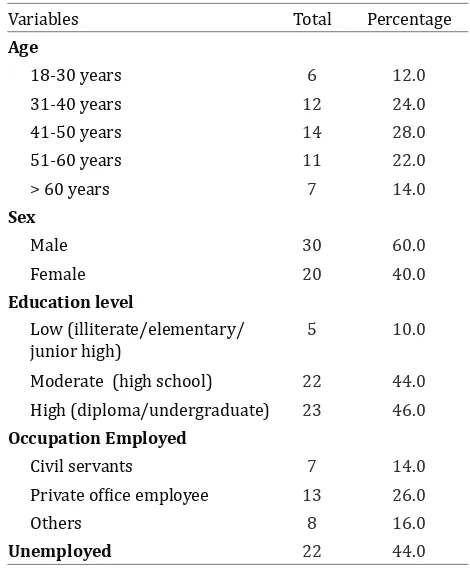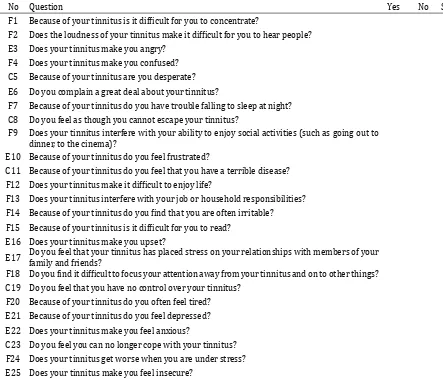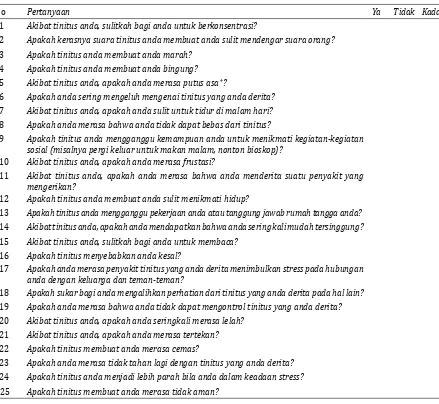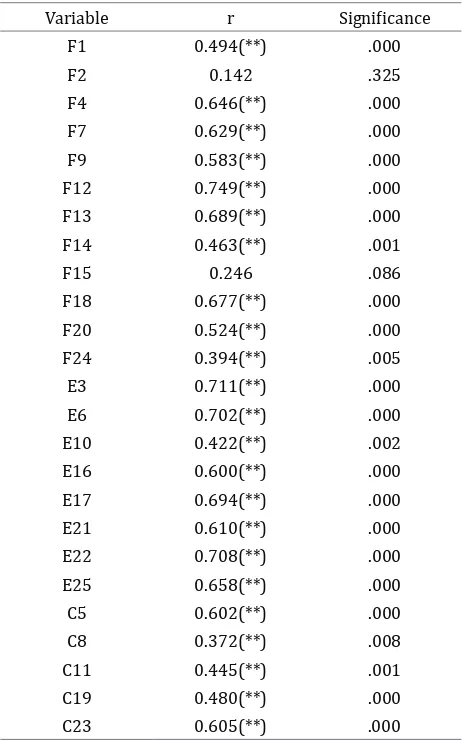Validity and reliability of the Indonesian version of tinnitus
handycap inventory
ABSTRAK
Latar belakang: Tinitus merupakan keluhan dibidang THT yang mempengaruhi kualitas hidup penderitanya. Rencana terapi salah satunya didasari pada hasil penilaian kualitas hidup pasien. Tinnitus Handycap Inventory (THI) adalah salah satu kuesioner yang banyak digunakan untuk melakukan penilaian kualitas hidup penderita tinitus. Penelitian ini bertujuan untuk melakukan proses translasi dan menguji validitas serta reliabilitas THI versi Bahasa Indonesia.
Metode: Studi menggunakan desain potong lintang yang dilakukan untuk menguji konsistensi internal, reliabilitas dan validitas THI versi Indonesia pada 50 orang penderita tinitus subjektif di Poli THT RSCM selama bulan Mei-Agustus 2010. 25 butir pertanyaan diterjemahkan dalam Bahasa Indonesia dan dilakukan terjemahan balik dan proses validasi dengan validasi transkultural WHO.
Hasil: Hasil uji validitas dalam tiga skala aspek penelitian adalah valid untuk skala emosi katastropik, dan skala fungsional kecuali pada butir pertanyaan nomor F2 dan F15. Uji reliabilitas dan keandalan konsistensi internal yang sangat baik pada keseluruhan skala (Cronbach-α = 0,9113).
Kesimpulan: Instrumen THI adaptasi Bahasa Indonesia valid
dan reliabel menurut kaidah validasi transkultural WHO sebagai instrumen psikometrik kualitas hidup pasien tinitus dan dapat digunakan untuk membantu dalam perencanaan terapi pasien tinitus.
ABSTRACT
Background: To translate and assess the validity and reliability of the Indonesian version of Tinnitus Handycap Inventory (THI) as an psychometric instrument for evaluating the quality of life in tinnitus patients. This instrument will support the clinicians to determine the appropriate tinnitus management for them.
Methods: A cross-sectional psychometric validation study was performed to assess the internal consistency, reliability and validity of the Indonesian version of THI in 50 subjective tinnitus patients at ENT outpatient clinic of Cipto Mangunkusumo Hospital between May-August 2010. 25 question items of original THI were translated, back-translated and validated using the transcultural validation by WHO.
Results: The validity test demonstrated a significant correlation in the emotional and the catastrophic scale whilst there was no significant correlation in the functional scale for item F2 and particularly for item F15. Nevertheless, the validity test on the functional scale showed a good result. This study also showed high internal consistency and
reliability for the total scale (Cronbach-α = 0.91)
Conclusion: The evaluation result indicated that the reliability of adapted Indonesian version of the THI in our study is relatively high and could be applied in clinical examination or further otolaryngology study by both specialists and general physicians.
Keywords: tinnitus, tinnitus handicap inventory, validity study
pISSN: 0853-1773 • eISSN: 2252-8083 • http://dx.doi.org/10.13181/mji.v24i1.1193 • Med J Indones. 2015;24:36-42 • Received 22 Jan 2015 • Accepted 09 Apr 2015
Correspondence author: Jenny E. Bashiruddin, [email protected] C l i n i c a l Re s e a rc h
Copyright @ 2015 Authors. This is an open access article distributed under the terms of the Creative Commons Attribution-NonCommercial-ShareAlike 4.0 International License (http://creativecommons.org/licenses/by-nc-sa/4.0/), which permits unrestricted non-commercial use, distribution, and reproduction in any medium, provided the original author and source are properly cited.
Jenny E. Bashiruddin,1,2 Widayat Alviandi,1 Alvin Reinaldo,2 Eka D. Saitri,2 Yupitri Pitoyo,2 Respati W. Ranakusuma2
1 Department of Otorhinolaryngology, Faculty of Medicine, Universitas Indonesia, Cipto Mangunkusumo Hospital, Jakarta, Indonesia
Tinnitus is defined as abnormal perception of
sound such as ringing or noise in the ears that may be accompanied with hearing loss.1 The etiology of tinnitus still has not been confirmed until now,
most cases even have unknown etiologies. The term tinnitus comes from the Latin word -tinnere,
which means ringing. It may also be defined as the
perception of sound in the absence of corresponding external sound stimulus. There is various auditory perception of tinnitus, which include buzzing, howling, hissing, whizzing or other various types of sounds. The sound produced may be high or low pitched, it may be loud or soft noise, it may also be continuous or intermitten.2 The management of
tinnitus still includes empirical treatment and it is still debatable until now.
In daily practice, an ear nose throat (ENT) often discovers patients experiencing a ringing in the ears. To establish the diagnosis, physicians will perform a series of diagnostic procedures, starting from history taking, physical examination including otoscopy, tuning-fork test, audiometry, tinnitus psychoaccoustic assessment and evaluation on the patient’s quality of life by using a psychometric instrument.
Tinnitus is a quite common complaint that could be found in daily practice.2 It may severely affect one’s
life that may disturb their work activity or even social life. Tinnitus may cause serious problems to the patient since it may affect their ability to concentrate and cause anxiety and depression that may lead to the impairment of quality of life.
There are many patients with complaints of tinnitus visit an ENT outpatient clinic in Cipto Mangunkusumo everyday. Based on the patient database of Neurotology Division ENT outpatient clinic Cipto Mangunkusumo Hospital, there were approximately 256 patients came with complaints of tinnitus with various underlying etiologies on
June 2008 to June 2009.
The primary goal of treatment is not just singular cure for the patients, but also to make the patients could carry out their daily activities as their normal life prior to the illness. Therefore, the effectiveness of treatment may not only be limited on clinical measure, but also on the quality of life in patients with tinnitus, which should be also evaluated in keeping with the executed management and treatment. Evaluation
on quality of life is a subjective matter, which is in accordance with the feeling and perception of the patients themselves by using a questionnaire as the measurement instrument. Among the most widely used questionnaire for tinnitus is the tinnitus handicap inventory (THI), which was developed in the United States of America.
However, there is no measurement tool in Indonesia to evaluate patients with a complaint of tinnitus. Therefore, we need the Indonesian version of the THI questionnaire which has undergone validity and reliability tests as a tool for quality of life assessment in patients with tinnitus.
METHODS
Our study used a cross-sectional design to evaluate the validity and reliability of the Indonesian version of THI psychometric instrument at the ENT outpatient clinic of ENT Cipto Mangunkusumo Hospital with 50 patients between May-August 2010. This research had approved by the Ethical Clearence Commitee from Faculty Medicine Universitas Indonesia and Cipto Mangunkusumo Hospital No. 231/PT02.FK/ETIK/2010.
Sample sized calculation based on data prevalence from Newman, et al3 is 52% and the total number patients for this study using formula is 50.
N=
Zα2xPxQ d2
Inclusion criteria were: (1) patients aged above 18 years with chief complaint of the subjective tinnitus, either continuous or intermittent, unilateral or bilateral; (2) with type A tympanogram result revealing normal condition in middle ear; (3) with pure-tone audiometry revealing normal condition
or sensorineural hearing loss; (4) with sufficient
Indonesian literacy, i.e. a good conduct in speaking, reading and writing Indonesian language.
Measures and procedures
evaluated by a committee consisted of investigators and neurotology consultants at Department of ENT, the methodology counselors and the translators. The translation result was reviewed and compared with the English version of THI. Translation results with coherent meaning were selected. After that, the result was back translated into English and subsequently being re-evaluated by the committee. The back translation in English was compared with the original version. We compared every question item in the original version of THI, the back translation and the translation results in Indonesian language. Correction on question items that may cause bias was performed and the correction was made in keeping with Indonesian culture. After the assessment, a study on the questionnaire was conducted.
The Indonesian version of the THI was administered to 10 model participants who had met the inclusion criteria. The evaluation on the result of the questionnaire study was discussed further by the committee. After the assessment, correction and adaptation with Indonesian culture, the elaboration of the Indonesian
version of the THI was finally made, which would
undergone subsequent questionnaire assessment for other model participants. Candidates
of model participants who had fulfilled the
inclusion criteria underwent history taking, ENT examination and audiological examination performed by the investigators. Afterward, the self-report adapted Indonesian version of the THI questionnaires were completed by the model participants. The completion of the questionnaire was made during their visits to ENT outpatient clinic at Cipto Mangunkusumo Hospital.
The validity test was conducted using the transcultural validation by WHO consists of internal validity test and internal instrument reliability test on adapted Indonesian version of the THI. The validity test was using the
Spearman’s correlation coefficient to measure
correlation between question items and its scores, whilst internal reliability test was used to analyze the consistency of question items using the Cronbach’s alpha.
Following the data collection from participants, we performed data analysis and processing using internal validity test and internal instrument reliability test.
RESULTS
The study involved 50 model participants, i.e. 30 male and 20 female subjects. The mean age was 46.6 years (SD ± 13.7), with the oldest age of 82 years and the youngest age was 18 years. Table 1 demonstrates that most participants were at the
fifth decades. The majority of subjects had high
education level at diploma or undergraduate level, which was found in 46.0% of subjects, followed by moderate education level at high school level or the equivalent found in 44.0% of subjects. Most model participants (56.0%) were employed and 44.0% participants had no employment.
The data on characteristic of tinnitus showed that most of participants described their tinnitus as pure tone or tonal tinnitus (68.0%). Right unilateral tinnitus was found in most participants, i.e. 20 model participants (40.0%); however,
it was not significantly different with the left unilateral tinnitus, which was found in 19 model
participants (38.0%). Most participants who had bilateral tinnitus experienced more severe complaints on their left side. About 35 model participants (70.0%) had continuous tinnitus over the day. Tinnitus was developed abruptly in
Variables Total Percentage
Age
18-30 years 6 12.0
31-40 years 12 24.0 41-50 years 14 28.0 51-60 years 11 22.0 > 60 years 7 14.0
Sex
Male 30 60.0
Female 20 40.0
Education level
Low (illiterate/elementary/ junior high)
5 10.0
Moderate (high school) 22 44.0 High (diploma/undergraduate) 23 46.0
Occupation Employed
Civil servants 7 14.0
Private office employee 13 26.0
Others 8 16.0
Unemployed 22 44.0
39 model participants (78.0%) and gradual onset
was found in 22% participants. The duration of less than a year tinnitus was experienced by 30 (60.0%) tinnitus.
Most participants, i.e. 40 participants (80.0%) described high-pitched tinnitus. About 23 model participants (46.0%) had no hearing impairment due to tinnitus and only 7 participants (14.0%) had severe hearing impairment. Approximately 22.0% of model participants felt that the tinnitus became louder, either in quiet or crowded surroundings.
Internal validation and reliability test
Validation of the THI was performed according to WHO principles on transcultural validation test. Before commencing the study, a written permission to perform the validation process has been asked from the copyright holder of the THI,
No Question Yes No Sometimes
F1 Because of your tinnitus is it difficult for you to concentrate?
F2 Does the loudness of your tinnitus make it difficult for you to hear people?
E3 Does your tinnitus make you angry?
F4 Does your tinnitus make you confused?
C5 Because of your tinnitus are you desperate?
E6 Do you complain a great deal about your tinnitus?
F7 Because of your tinnitus do you have trouble falling to sleep at night?
C8 Do you feel as though you cannot escape your tinnitus?
F9 Does your tinnitus interfere with your ability to enjoy social activities (such as going out to
dinner, to the cinema)?
E10 Because of your tinnitus do you feel frustrated?
C11 Because of your tinnitus do you feel that you have a terrible disease?
F12 Does your tinnitus make it difficult to enjoy life?
F13 Does your tinnitus interfere with your job or household responsibilities?
F14 Because of your tinnitus do you find that you are often irritable?
F15 Because of your tinnitus is it difficult for you to read?
E16 Does your tinnitus make you upset?
E17 Do you feel that your tinnitus has placed stress on your relationships with members of your
family and friends?
F18 Do you find it difficult to focus your attention away from your tinnitus and on to other things? C19 Do you feel that you have no control over your tinnitus?
F20 Because of your tinnitus do you often feel tired?
E21 Because of your tinnitus do you feel depressed?
E22 Does your tinnitus make you feel anxious?
C23 Do you feel you can no longer cope with your tinnitus?
F24 Does your tinnitus get worse when you are under stress?
E25 Does your tinnitus make you feel insecure?
Table 2. The original questionnaire prior to the translation
Craig Newman MD in Cleveland, United States of America. The study was conducted after having his consent on validation of the THI.
The final version of the THI used in our study had linguistic and cultural revisions. At first, we included the concept and definition of the word
-tinnitus in the questionnaire. However, the term -tinnitus is not a common word in Indonesian language, but it is a general medical term. The word is not intended to be understood by a
layman; therefore, a definition of -tinnitus was
the end of the questionnaire, we also included the concept of word -despair since the model
participants asked for clarification about the
meaning of the word. Some sentences had been
revised as follows: F18 “Do you find it difficult
to focus your attention away from your tinnitus
and on to other things?”, C19 ”Do you feel that
you have no control over your tinnitus?”, and
C23 ”Do you feel you can no longer cope with your tinnitus?”.
The above mentioned sentences were revised
into: F18 “Is it difficult for you to get your
attention away from your tinnitus on to other
things?”, C19 “Do you feel that you can not control
your tinnitus?” C23 “Do you feel you can no longer bear with your tinnitus?”
No Pertanyaan Ya Tidak Kadang-kadang
F1 Akibat tinitus anda, sulitkah bagi anda untuk berkonsentrasi?
F2 Apakah kerasnya suara tinitus anda membuat anda sulit mendengar suara orang? E3 Apakah tinitus anda membuat anda marah?
F4 Apakah tinitus anda membuat anda bingung? C5 Akibat tinitus anda, apakah anda merasa putus asa*?
E6 Apakah anda sering mengeluh mengenai tinitus yang anda derita? F7 Akibat tinitus anda, apakah anda sulit untuk tidur di malam hari? C8 Apakah anda merasa bahwa anda tidak dapat bebas dari tinitus?
F9 Apakah tinitus anda mengganggu kemampuan anda untuk menikmati kegiatan-kegiatan sosial (misalnya pergi keluar untuk makan malam, nonton bioskop)?
E10 Akibat tinitus anda, apakah anda merasa frustasi?
C11 Akibat tinitus anda, apakah anda merasa bahwa anda menderita suatu penyakit yang mengerikan?
F12 Apakah tinitus anda membuat anda sulit menikmati hidup?
F13 Apakah tinitus anda mengganggu pekerjaan anda atau tanggung jawab rumah tangga anda? F14 Akibat tinitus anda, apakah anda mendapatkan bahwa anda sering kali mudah tersinggung? F15 Akibat tinitus anda, sulitkah bagi anda untuk membaca?
E16 Apakah tinitus menyebabkan anda kesal?
E17 Apakah anda merasa penyakit tinitus yang anda derita menimbulkan stress pada hubungan anda dengan keluarga dan teman-teman?
F18 Apakah sukar bagi anda mengalihkan perhatian dari tinitus yang anda derita pada hal lain?
C19 Apakah anda merasa bahwa anda tidak dapat mengontrol tinitus yang anda derita? F20 Akibat tinitus anda, apakah anda seringkali merasa lelah?
E21 Akibat tinitus anda, apakah anda merasa tertekan? E22 Apakah tinitus membuat anda merasa cemas?
C23 Apakah anda merasa tidak tahan lagi dengan tinitus yang anda derita? F24 Apakah tinitus anda menjadi lebih parah bila anda dalam keadaan stress? E25 Apakah tinitus membuat anda merasa tidak aman?
Table 3. Final Indonesian version of adapted and revised THI “Tinnitus: sound in the ear (buzzing/ringing/roaring/hissing/howling/
thundering)”
*) Putus asa = despair : to lose hope or no more hope (of a cure for illness)
DISCUSSION
The transcultural validation in Jakarta is different from validation process in Brazil. Revised sentences in items 1, 10 and 24 were related to the word -concentration, -frustrated and -stresses, which were unclear for 3.0% of the patients in Brazil.3
According to Ferreira, et al3 when there is difficulty
WHO. The reliability and validity tests in our study have demonstrated that those three question items are valid and reliable.
The validity test was performed in our study by measuring the correlation between each question item and the total score of questions and by analyzing
them with Spearmann correlation coefficient
test.4 Our study found a significant correlation in
emotional and catastrophic scale. In contrast, there was an invalid correlation in the functional scale i.e.
for item F2 and especially on item F15. Item F2, i.e.” Does the loudness of your tinnitus make it difficult for you to hear people?” was evaluated as invalid result and had no significant correlation with total
score. It probably occurs due to self perception of the questionnaire by the model participants considering that the questionnaire is a self-report
tool. Moreover, we could find that most patients had
Variable r Significance
F1 0.494(**) .000
F2 0.142 .325
F4 0.646(**) .000
F7 0.629(**) .000
F9 0.583(**) .000
F12 0.749(**) .000
F13 0.689(**) .000
F14 0.463(**) .001
F15 0.246 .086
F18 0.677(**) .000 F20 0.524(**) .000
F24 0.394(**) .005
E3 0.711(**) .000 E6 0.702(**) .000 E10 0.422(**) .002 E16 0.600(**) .000
E17 0.694(**) .000
E21 0.610(**) .000 E22 0.708(**) .000 E25 0.658(**) .000 C5 0.602(**) .000 C8 0.372(**) .008 C11 0.445(**) .001
C19 0.480(**) .000 C23 0.605(**) .000
**) p < 0.01 was considered significant
Table 4. Validity test using the total scale scores of Spear-mann correlation coefficient on adapted Indonesian version
of the THI
Scale Cronbach-α
Functional 0.8356 Emotional 0.8438 Catastrophic 0.6950
THI total 0.9113
Table 5. Reliability test on adapted Indonesian version of
the THI
Minimal Cronbach-α was 0.7
no hearing impairment although the symptom of tinnitus was positive. However, based on the validity assessment of functional scale, we found a relatively
significant value; therefore, the question should be
re-adjusted on the understanding the sentence of the question.
Item F15 which stated ”Because of your tinnitus is it difficult for you to read?” has emphasized the
meaning of -read as to observe and understand the content of written statement (both by reading it loudly or reading it by heart). When referring to such concept, then the model participants may have different understanding of meaning and regard the term -read as reading something casually causing the item to be not valid. Furthermore, the meaning of the word -reading by cultural aspect in our country is different from the developed countries (particularly, in United States where the THI was established), where reading has become their needs. Such situation does not apply in developing countries including Indonesia. Reading has not become our daily needs. It is just an activity for leisure time.5,6 The
word -reading here is regarded as a casual activity and the tinnitus does not affect the activity. The situation is different in developed countries, where such activity has become daily routine. However, it should be considered that reading activity is increasing in Indonesia nowadays, especially for urban community and the activity has become a fun activity.7 Thus, the question about tinnitus may not
for treatment including housewives and retired participants as well as various ethnic backgrounds that may cause misunderstandings on word utilization in the questionnaire. Considering the abovementioned points, the question should be re-adjusted on the understanding of sentence of the question.
The reliability test in our study includes intra-observer reliability test and internal consistence. The study result of adapted Indonesian version of THI demonstrated excellent reliability and consistent internal reliability at all scales
(Cronbach-α = 0.9113), which is similar with
the original version of reliability test or THI in
United States of America (Cronbach-α = 0.93).8
The assessment of reliability on the three scales, i.e. functional, emotional and catastrophic scales
has demonstrated a relatively adequate result (α = 0.8356, α = 0.8438, α = 0.6950), which also had
similar result to the study conducted in the United
States of America or the original version (α = 0.86, α = 0.87, α = 0.68).
Both reliability tests demonstrated low alpha score in catastrophic scale, which was related to less number of question items in the scale.9
Another investigator, Ghozali10 also supported
the fact who stated that an instrument may have
high reliability rate if the coefficient value found is ≥ 0.60. Considering that item C19 mentioning
about the patients’ problem in controlling their tinnitus, then the question item is still necessary both in pra- and post-treatment evaluation. According to Cronbach, as quoted by Monzani, et al.11 since there was lack of low alpha coefficient score (0.907 - 0.913), which was correlated to the
three scales when each question item has been deleted, then it is assumed that there is no altered
reliability although the result of Cronbach-α in
catastrophic scale is low due to lack number of question items. The evaluation result indicated that the reliability of adapted Indonesian version of the THI in our study is relatively high and could be applied in clinical examination or further otolaryngology study by both specialists and general physicians.
In conclusion, the adapted Indonesian version of THI instrument is valid and reliable according to the transcultural validation principles by WHO as psychometric instrument on the quality of life in patients with tinnitus and adapted Indonesian
version of THI instrument, which could be utilized as self-assessment of quality of life in patients with tinnitus.
Acknowledgment
The authors are grateful to Division of Neurotology Department of Otorhinolaryngology Cipto Mangunkusumo Hospital and Faculty of Medicine, Universitas Indonesia.
Conflict of interest
The authors affirm no conflict of interest in this
study.
REFERENCES
1. Heyning PV, Meeus O, Blaivie C, Vermeire K, Boudewyns A, Ridder DD. Tinitus: a multidisciplinary clinical approach. B-ENT. 2007;3(Supll7):3-10.
2. Bashiruddin J, Sosialisman. Tinitus. In: Soepardi EA, Iskandar N, Bashiruddin J, Restuti RD, editors. Buku ajar ilmu penyakit telinga hidung tenggorok kepala dan leher, 6th ed. Jakarta: Balai Penerbit FKUI; 2007. p. 111-113. Indonesian.
3. Newman C, Sandridge S, Jacobson G. Psychometric adequacy of the tinnitus handicap inventory for evaluating treatment outcome. J Am Acad Audiol.
1998;9(2):153-60.
4. Ferreira PÉA, Cunha F, Onishi ET, Branco-Barreiro FCA, Ganança FF. Tinnitus handicap inventory: cross-cultural adaptation to Brazilian Portuguese. Pró-Fono R. Atual. Cient. 2005;17(3):303-10.
5. Riwidikdo H. Uji validitas dan reliabilitas. In: Setiawan A, editor. Statistik kesehatan. Yogyakarta: Mitra Cendekia Press; 2008. p. 151-61. Indonesian.
6. Repository.usu.ac.id [Internet]. Sumatera Utara: USU digital library [update 2004; cited 2009 July]. Available from: http://
repository.usu.ac.id/bitstream/123456789/1780/1/
perpus-ridwan4.pdf. Indonesian.
7. isjd.pdii.lipi.go.id [Internet]. Jakarta: Mengapa kebiasaan
membaca masih belum berkembang? [update 2008, cited 2009 Sept]. Available from: http://isjd.pdii.lipi.go.id/
index.php/Search.html?act=tampil&id=8617&idc=34. Indonesian.
8. Sugihartati R. Membaca, gaya hidup dan kapitalisme, kajian tentang reading for pleasure dari perspektif cultural studies. 1st ed. Yogyakarta: Graha Ilmu; 2010.
9. Zacharie R, Mirz F, Johansen LV, Andersen SE, Bjerring
P, Pedersen CB. Reliability and validity of Danish adaptation of the Tinnitus Handicap Inventory. Scand
Audiol. 2000;29(1):37-43.
10. Ghozali I. Aplikasi analisis multivariate dengan program SPSS. Semarang: Badan Penerbit Universitas Diponegoro; 2002. Indonesian.



